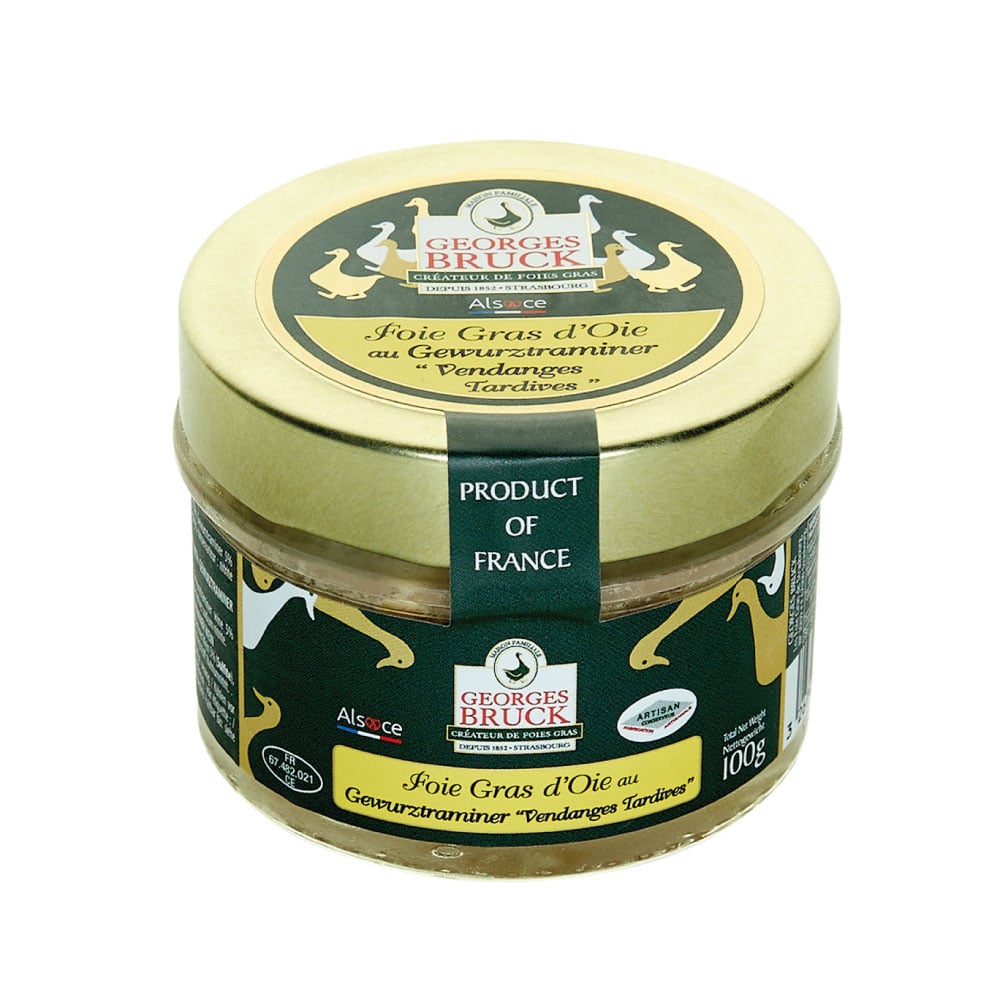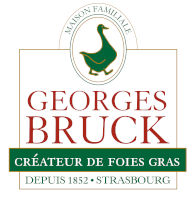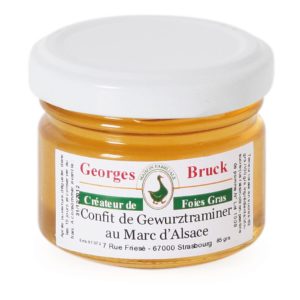
GOOSE FOIE GRAS WITH GEWURTZMANIER WINE IN GLASS JAR
27.50€ – 50.00€

Chronofresh delivery

Handcrafted and family-run in Strasbourg
Description, Ingredients & Tasting Tips
Description :
The aromatic palette of this Alsatian grape variety harvested in “late harvest” harmoniously accompanies the mellowness and softness of goose foie gras.
In its easy-to-open, resealable jar, you can enjoy it for longer.
Guaranteed GMO-free, antibiotic-free, reduced nitrite salt content.
Ingredients, allergens, preservation, nutritional values :
Ingredients: Goose foie gras, Gewurztraminer 5%, edible salt, spices, preservative: sodium nitrite.
Allergens: sulphites
Storage: unopened, the verrine can be stored for 2 years in a cool, dry place away from direct light.
Average nutritional values per 100g: Energy 1730 kJ / 416 kcal, Fat 41g of which saturated fatty acids 17g, Carbohydrates 2,2g of which sugars 2,2g, Protein 8,4g, Salt 1,38g
Tasting advice:
100g ideal for 2 people.
200g ideal for 3 to 4 people.
Glaze before serving, remove from the fridge 5 to 10 minutes before serving. Open the jar and slide the contents onto a plate. Cut slices with a knife dipped in very hot water, serve directly on a plate and enjoy with a good lightly toasted country bread.

How much per person?For the aperitif on toast, allow 30 grams per person. Avoid spreading it, it is a noble product. With a knife previously dipped in hot water, cut it into thin slices, adjusted to the size of the toasts.
For a foie gras served in slices on a plate as a starter, allow 50 grams per guest.
For a pan-fried foie gras, count 100 grams if it is a starter, or 150g as a main course.What is the difference between goose and duck foie gras? Goose foie gras has a very subtle flavour, it is fine with a slight bitterness that tends to be pronounced in the aftertaste. Its colour is pinkish beige.
Duck has more character, its taste is more assertive and its flavours more pronounced. Its colour is more of a beige colour tending towards yellow.
What is the difference between semi-cooked and canned foie gras?
The difference is linked to the cooking time. Semi-cooked (or semi-preserved) foie gras is pasteurised, i.e. it has been cooked through at a temperature below 100°C. It must be kept in a cool place and can be kept for between 3 weeks and 9 months depending on the length of time it has been cooked. This preparation preserves the freshness and the flavours of the liver. Preserved foie gras is sterilised, i.e. it has been cooked at a temperature above 100°C in an autoclave. It can be kept at room temperature for several years.
Why is it necessary to place canned foie gras in the refrigerator before eating it?
Foie gras should be eaten fresh so that it is firm. A foie gras at room temperature will have a melted and fatty texture which does not enhance it.
Even for a preserve, it is necessary to place it in the refrigerator for several hours before eating; then remove it from the mould 5 to 10 minutes before consumption.
What is the shelf life of foies gras?
For canned foie gras, the shelf life is between 2 and 4 years, for a semi-cooked foie gras it is 6 to 9 months and for a cooked foie gras, it is generally 28 days. All the shelf lives are indicated on the product sheet.
How long can I keep my opened foie gras?
If you do not finish it, it is important to put it back in the fridge quickly. Foie gras will keep for about 2 days, but will tend to oxidize. That is why it is recommended to cover the opened part with a piece of cling film before putting it back in the fridge.
OPINION
FOIE GRAS GEORGES BRUCK STRASBOURG

+50 opinion





